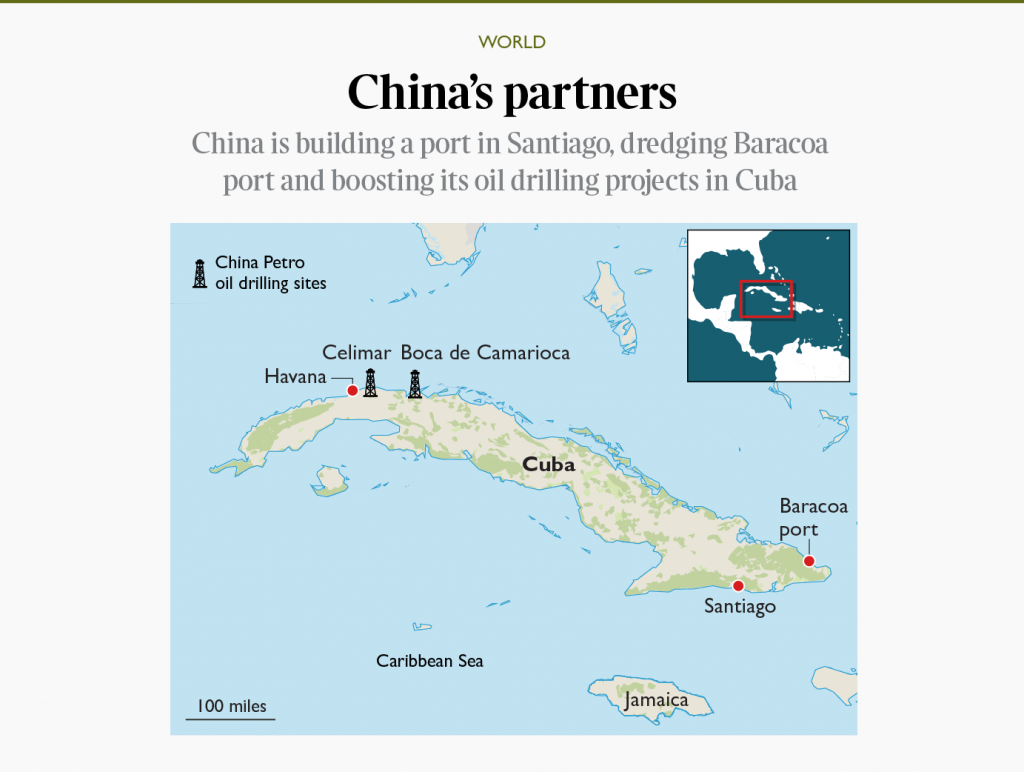Original Article: Cuba-China Energy pact
Stephen Gibbs, Caracas
The Times, Tuesday October 19 2021,

President Xi meets Fidel Castro during a visit to Cuba in 2014
Cuba has signed up to an energy cooperation pact with China, solidifying relations at a time when the US has been cautioning against the Asian giant’s growing influence in the region.
Chinese companies will be invited to upgrade Cuba’s ageing energy sector. The financing for the project is expected to be backed by the Chinese government.
The announcement comes as the Biden administration attempts to convince countries in Latin America to turn away from China’s Belt and Road trade and public works programme, which critics say traps recipients in unsustainable debt, while providing Beijing raw materials and geopolitical leverage for decades to come.
At a conference of the “Belt and Road energy partnership”, held in Qingdao, a delegation from Cuba said it would “deepen ties” between the two countries. Cuba’s industry minister, Liván Arronte Cruz, said the pact would “promote solidarity and international co-operations in favour of developing countries”. Green technologies will be prioritised, the minister said.
The other countries in the region which have signed up to the broad Chinese cooperation agreement are Bolivia, Suriname, and Venezuela, all of which have left-wing governments.
ver the past 15 years, China has become the biggest trading partner for most of the big economies in Latin America, overtaking the United States. More recently, China has spent billions of dollars buying up several key energy companies in the region, including the largest electrical company in Peru.
Earlier this month, President Biden’s deputy national security adviser Daleep Singh visited Colombia, Ecuador and Panama, all of which have conservative governments, as part of a pitch for US-backed infrastructure funding, called “Build Back Better World”. US officials say the so-far undefined projects on offer will be built to higher environmental and labour standards than those China is financing, with full transparency for the terms, in contrast to Beijing’s secrecy.
Singh however has insisted that Washington is not asking the region to make a stark choice between the US and China. “We’re there to compete because we do think we have a better product,” he told the Financial Times. China’s arrangement with Cuba, a political ally and one of the smallest economies in the region, is not seen as likely to trouble the Biden administration, given it maintains the US’s decades-old embargo on the communist island, prohibiting most American companies from doing any business with its ruling regime. But it is seen as symbolic of Beijing’s increased clout at the doorstep of the United States.
Already Cuba is China’s largest trading partner in the Caribbean. China is helping Cuba build a modernised port in the city of Santiago, as well as undertaking dredging operations, and setting up wind and solar farms. ChinaPetro, the state oil conglomerate, is running drilling rigs in Celimar and Boca de Camarloca. China’s direct investments in Cuba reached $149 million at the end of 2019.
President Xi last visited Cuba in 2014, when he met the former dictator of the island Fidel Castro. “The common dream and pursuits have brought China and Latin America closely together,” he told a conference later. “Let’s seize the opportunity, work hard, advance hand-in-hand and create a beautiful future for the China-Latin America relations”, he said.
Others suspect more nefarious aims, and there are suspicions that Beijing bases some of its regional intelligence on the island. US media reports have claimed a Soviet-era signals station near Havana is operated by China to intercept communications in the US.
Any further help China can offer to improve the Cuban energy network will be welcomed by its communist leadership. Electrical blackouts since June have fuelled discontent, which in July broke out into street protests, the largest seen since the 1959 revolution.
Following those protests, after the US sanctioned Cuba’s national revolutionary police and its top two officials, China said: “The recent US sanctions against Cuban institutions and officials severely violate the basic norms governing international relations.”
HAVANA IS
A WILLING ALLY FOR XI
First it was the Soviet Union, then it was Venezuela (Stephen Gibbs writes).
Will China now step in as Cuba’s next patron to ensure the survival of the last
communist bastion in the western hemisphere?
Cuba’s dependence on China is growing. In 2014, President Xi visited Fidel Castro and assured the retired revolutionary that he would “inject new impetus” into bilateral relations.
By 2017, China had become the island’s main trading partner. Cuba joined China’s Belt and Road infrastructure initiative in 2018.
The evidence of Beijing’s influence is everywhere. Yutong buses and Geely cars are common sights in Havana. Modern Chinese trains can occasionally be seen on the island’s decrepit railways. A brand new Haier fridge or washing machine has become a status symbol among those few Cubans that can afford such luxuries.
Chinese companies have also played a key part in Cuba’s telecommunications infrastructure, a role which some see as having sinister undertones. During anti-government protests last July, the government shut off the internet in demonstration hotspots, using technology thought to come from China.
Those protests were partly fuelled by weeks of power cuts in high summer. Finding the fuel for Cuba’s old-tech power stations has long been a challenge.
During the Cold War, Cuba would get most of its oil from the Soviet Union in exchange for sugar, a spectacularly good deal on the Cuban side. More recently it has been receiving subsidised fuel from Venezuela, but its own economic collapse means Caracas has become far less generous, sending about half as many barrels per week as it once did.
China has far deeper pockets and sees Cuba as an important foothold to expand its influence in the Americas. Propping up an amenable Cuban regime is part of that strategy.


